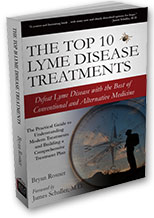|

Author Ken Singleton, M.D.
Excerpts from the Lyme Disease Solution:
Table
of Contents
Introduction
Chapter 1
Chapter 2
Chapter
3
Chapter 4
Chapter 5
Chapter 6
Chapter 7
Chapter 8
Chapter 9
Index
See our complete selection
of Lyme disease books and DVDs.
Customers who purchased The Lyme Disease Solution also
purchased the following book:

The Top 10 Lyme Disease
Treatments by Bryan Rosner
|
|
Paperback Book, 523 Pages, $29.95

Types of Antibiotic Drugs for Treating Other Tick-Borne Diseases
What follows are the antibiotic treatments I have found to be most effective for treating the co-infections—the tick-borne diseases often coexisting with Lyme infection.
Bartonella/BLO
There are two antibiotics that have been found to be most useful for treating Bartonella/BLO. My choice of these two antibiotics depends on two issues: (1) the extent to which the central nervous system (CNS) is affected and (2) the presence of co-infections other than Bartonella/BLO.
Levofloxacin (Levaquin)
This antibiotic is generally considered to be the antibiotic of choice for the treatment of Bartonella/BLO. Levaquin is a member of the family of antibiotics known as fluoroquinolones, which also includes ciprofloxacin (Cipro). All the fluoroquinolones seem to have activity against Bartonella/BLO, but Levaquin seems to be the most effective. The dosage is 250-500 mg once a day. It is best to take Levaquin on an empty stomach (or with minimal food if you need to eat something due to gastrointestinal side effects). Also, it is important not to take minerals like calcium, zinc, iron, and magnesium within several hours of the dose of Levaquin, because these minerals will bind Levaquin and render it less effective. I advise that patients take levofloxacin early in the morning, or it can be taken late in the evening, but not at bedtime. Except for the tetracycline antibiotic group, the fluoroquinolones are not generally used in combination with other antibiotics. Usually the course of treatment for Bartonella/BLO is one to three months, but occasionally it may take much longer.
Precautions: Levaquin is usually very well tolerated. The major adverse reaction that may occur with use of this medication is tendonitis (inflammation of the tendons). This complication is not common, but when it occurs, the medication must be stopped for a few days to allow symptoms to resolve. It can then be restarted in a few days at a lower dose, but if the tendonitis recurs, the medication should be stopped. The mechanism for tendonitis is not clearly known, but magnesium deficiency may The play a role in some patients. For this reason, I recommend that Bartonella/BLO patients ideally take 600–1,000 mg of magnesium for two weeks before beginning Levaquin therapy. Once Levaquin is begun, the patient should continue the magnesium, being careful to take it three (or more) hours before or after the dose of
Levaquin.
Rifampin
Rifampin is a very old antibiotic that for many years has been used for the treatment of chronic infections such as tuberculosis. It is very effective against Bartonella/BLO. In particular, it is very useful for the neurological and psychiatric manifestations of Bartonella/BLO—severe anxiety and mood swings, panic, seizure-like episodes, memory loss, “spaciness,” confusion, disorientation episodes, and many other symptoms. Expect a herx-like reaction during the first week or so; then significant progress often occurs during the second or third week on rifampin.
It is best used in combination with certain other antibiotics. Frequently, those combinations include rifampin with doxycycline or rifampin with clarithromycin. The combination of rifampin with doxycycline is especially helpful when a patient with Bartonella/BLO is also infected with either Ehrlichia or Lyme. The dosage of rifampin is 300 mg per day for the first week; increase to 600 mg once a day after the first week. It is advisable to use rifampin in the evening (not at bedtime) on an empty stomach, three hours or more after a meal. It may be used in the morning an hour before breakfast also.
Rifabutin is a medication in the same family as rifampin and is reportedly very effective against Bartonella also. Apparently, it can be combined effectively with azithromycin. I do not have enough experience with its use to recommend it at this time.
Precautions: Rifampin is usually very well tolerated. It will always turn a patient’s urine orange. It may cause headaches and sleepiness. Liver function and blood counts should be monitored at regular intervals while using rifampin. The greatest concern about rifampin is the potential for interactions with other medications. Rifampin speeds the metabolism of certain medications, resulting in an increased breakdown of the other medications. Clinically, this drug-interaction issue often becomes a problem when certain pain medications are being used, and often a patient will require higher doses of pain medications while on
rifampin.
Babesia
This parasitic organism can live inside the body’s red blood cells for four months or more. It usually requires a combination antibiotic treatment for a period of two to four months to effectively control the infection. The following two medications are used in combination with a macrolide for treating Babesia.
Atovaquone (Mepron)
Atovaquone may be used alone as in the product called Mepron or used in combination with proguanil as in the product called Malarone. Both preparations are effective against Babesia. Mepron is the most common form of atovaquone used against Babesia and is typically combined with azithromycin (Zithromax). Mepron is a liquid that looks similar to yellow paint and is taken as one to two teaspoons twice a day. It should always be taken with fatty food (such as nuts, cheese, or similar food), because it is much better absorbed by the body when it is ingested along with a fatty meal. Generally, I cycle Mepron’s use as follows: three weeks on the medicine, and one week off. Azithromycin is continued for all four weeks.
Precautions: There are important precautions related to atovaquone. The first is that it can cause temporary liver damage, and for that reason, blood tests for liver function must be followed on a regular basis while using either of these medications. The second precaution concerns the use of supplement doses of coenzyme Q10, alpha lipoic acid, and vitamin E while on atovaquone. These should not be used while taking atovaquone because they are all fat-soluble antioxidants that tend to neutralize the pro-oxidant effects of atovaquone against Babesia.
Bactrim or Septra (trimethoprim/sulfamethoxazole)
Bactrim,
Septra, TMP/SMX all refer to the same medication. Like rifampin, it is a very old medication that has been used for many years to treat a host of acute and chronic infections, including parasites. It is very effective, especially when combined with a macrolide such as clarithromycin or azithromycin. The usual dosage is one Bactrim DS twice a day. At times, four or more Bactrim per day may be used, depending on the clinical situation.
Precautions:
The vast majority of patients using Bactrim have no problems at all. However, as with most antibiotics, it is important to follow routine blood work (complete blood count and liver function tests) on a regular basis. In addition, Bactrim may rarely cause a severe reaction called “Stevens-Johnson” syndrome which can be lethal if not addressed immediately. This serious reaction is usually characterized by fever, flu-like symptoms, mouth sores, and often a skin rash. My patients are instructed to stop Bactrim immediately if any fever or mouth and/or skin sores occur. The condition usually clears in the next 24 to 72 hours. However, if it worsens, the patient needs to seek emergency care.
Ehrlichia/Anaplasma
The key to effective treatment of these organisms is early suspicion and treatment for at least 28 days. The most useful antibiotics for treating Ehrlichia/Anaplasma are doxycycline (100–200 mg twice a day) or rifampin (600 mg once a day). In difficult or resistant cases, I have used a combination of both drugs with very good success.
If you would like
to learn more about the book before ordering it, feel free to browse
these excerpts, which are available online, free of charge:
Table
of Contents • Introduction
• Controversy
and Background
Symptoms
• Testing
and Diagnosis • Natural
Killer (NK) Cells
Anti-Inflammation
Diet • Medical
History and Physical Exam
Low
Dose Naltrexone (LDN) • Food,
Diet, and Omega Fatty Acids
Hope
and Positive Outlook • Index
"What I have accomplished with this 500+ page book, The Lyme Disease Solution, is to share my everyday knowledge and practical experience of 10 years as a Lyme-enlightened practitioner (who also is himself a Lyme-survivor). Although I hesitate to use the “cure” word in relation to chronic Lyme, the principles in this book have resulted in a greater than 90% response rate in my patients. At least 60% of my patients achieve long-term improvement that allows them to get off of antibiotics completely."
— Ken Singleton, M.D.
|
THE LYME DISEASE SOLUTION
By Ken Singleton, M.D.
Foreword by James A. Duke, Ph.D.
Paperback Book, 523 Pages, $29.95 + $7 Shipping & Handling |
|

|
Order By Phone: |
Order Online: |
| (530) 541-7200 |
 |
 |
BioMed
Publishing Group
P.O. Box
9012
South Lake
Tahoe, CA 96150
www.LymeBookStore.com
Contact Us
(801)
925-2411
|
Disclaimer:
The
products offered on this web site are intended for
informational and educational purposes only and are not
intended to prevent, diagnose, treat, or cure disease.
The statements on this web site have not been evaluated by
the United States Food and Drug Administration. If you have
a medical problem see a licensed physician.
Copyright
© 2007 BioMed | Advertise
with us
|
|
